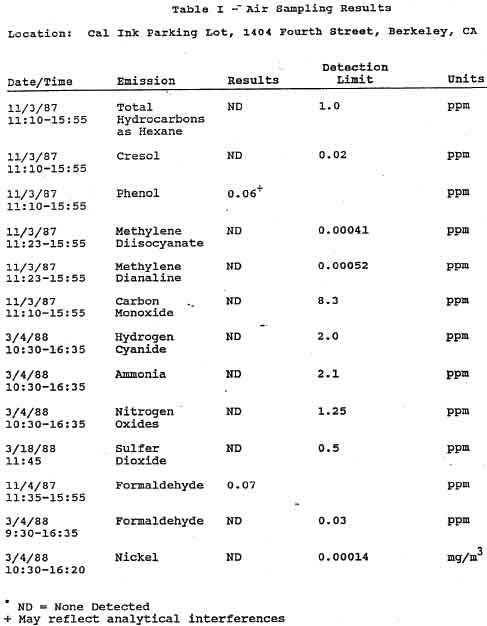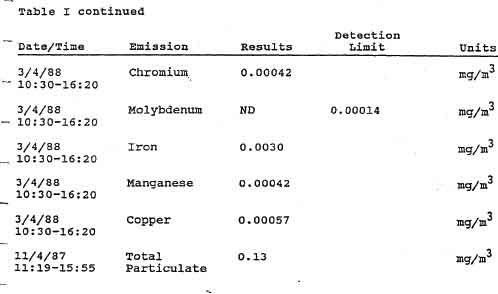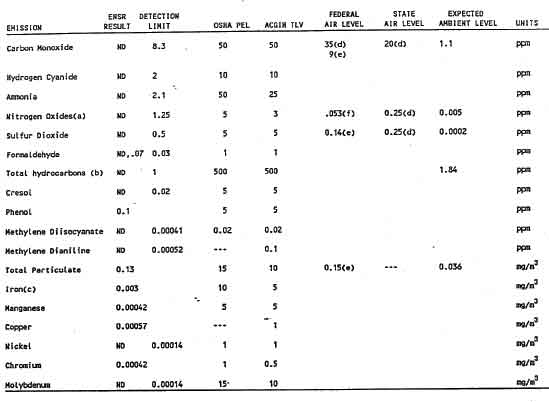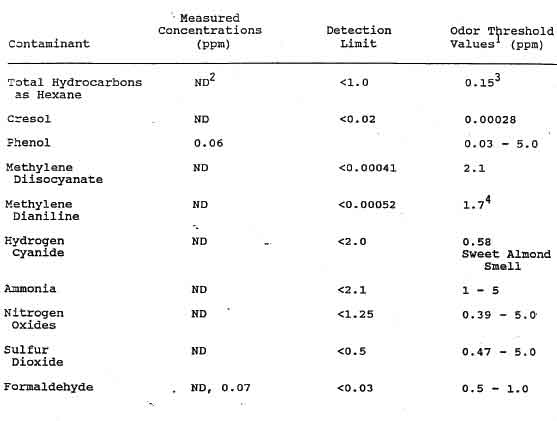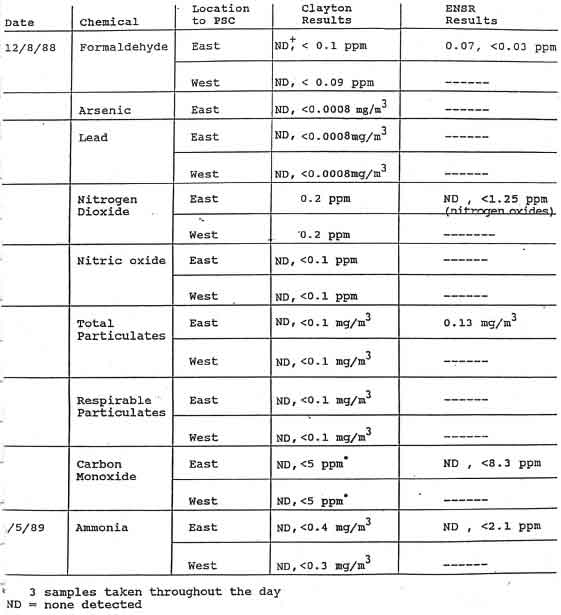
A Screening Assessment of Ambient Air
(Note that this screening assessment used ONLY five (5) days of actual sampling conducted over approximately a fourteen month period)
A Screening Assessment of Ambient Air funded by Pacific Steel Casting Company, Berkeley, California, ENSR Health Sciences (Formerly EHA) March 1989 Document Number 5980001
TABLE OF CONTENTS
EXECUTIVE SUMMARY
Introduction
ENSR Sampling Parameters
Results of ENSR Sampling
Results of Survey by Clayton Environmental Consultants
Discussion
Conclusion
Tables:Table I. Air Sampling Results
Table II. Comparison of Air Sampling Results with Regulatory Standards and Expected Ambient Levels
Table III. Comparison of Air Sampling Results with Reported Odor Thesholds
Table IV. Clayton Environmental Air Sampling Results
Figure I. Clayton/ENSR Environmental Air Sampling Locations
Appendix 1 - Methods and Instrumentation (not included)EXECUTIVE SUMMARY
In late 1987 and early 1988, ENSR Health Sciences (formerly Environmental Health Associates) performed a screening evaluation of ambient air in the vicinity of Pacific Steel Casting Company (PSC) operations. The purpose of the evaluation was to (1) identify levels of potential plant emissions that could be producing objectionable odors in the neighborhood and (2) to determine if such emissions could pose potential health hazards for the community. The ENSR monitoring survey was not intended to meet state or federal criteria for ambient air monitoring.
ENSR conducted outdoor air sampling at a single downwind location for eighteen substances potentially generated by the PSC processes, including substances thought to be detected by the staff and clients of a neighborhood (Duck's Nest) preschool. The substances monitored were total hydrocarbons, cresol, phenol, methylene diisocyanate, methylene dianiline, carbon monoxide, hydrogen cyanide, ammonia, nitrogen oxides, sulfur dioxide, formaldehyde, iron, manganese, copper, nickel, chromium, molybdenum and total particulates.
Results of sampling performed on November 3, 1987 and March 4 and 18, 1988 showed either very low concentrations of the substances monitored or levels that were below the detection limits of the screening methods utilized. A detectable level of formaldehyde (0.07 ppm) was found on only one of the two days on which sampling was conducted. This level of formaldehyde may be perceived as mildly, odoriferous and could cause very mild, temporary eye irritation and throat dryness in susceptible individuals.
In February of 1989, PSC requested that ENSR review results of air sampling performed by Clayton Environmental Consultants, Inc. (Clayton). Clayton conducted air monitoring for formaldehyde, arsenic, lead, nitrogen dioxide, nitric oxide, carbon monoxide and particulates at two locations on December 8, 1988; sampling for ammonia was performed on January 5, 1989. Two of these substances (lead and arsenic) had not been included in the ENSR survey. Two formaldehyde samples collected showed non-detectable levels (detection limit of the method less than 0.1 ppm). The Clayton results were consistent with the findings of the earlier ENSR survey.
Airborne substances such as hydrogen cyanide, cresol and ammonia may be detected by smell at low concentrations that are well below the detection limits of the screening methods employed in the ENSR and Clayton surveys. Therefore, although these substances were not detected during the sampling periods, very low levels of odoriferous chemicals could be present and result in mildly objectionable odors. It is possible that the odors detected near PSC are due to low levels of several chemical compounds or combinations of them. Based on current medical information, exposure to the concentrations of 20 substances measured by ENSR and/or Clayton would not pose a chronic health hazard to members of the surrounding community.
In response to concerns raised by parents at a nearby preschool (Duck's Nest), PSC engaged ENSR in September 1987 to perform a survey of ambient air. Air monitoring was conducted at a location between PSC and the (Duck's Nest) preschool on days when the preschool was downwind from PSC (wind direction from the west/southwest). The sampling location selected was in the Cal Ink Company parking lot, which is directly across the street from the (Duck's Nest) preschool.
ENSR encountered difficulty in selecting test days when all of the required parameters for acceptable sampling were present: appropriate meteorological conditions, wind blowing towards the preschool for a sufficient period of time to permit adequate sample collection, full production activity at PSC, and available ENSR equipment and personnel. Due to these requirements, testing was performed on three occasions over a five month period.
Kit Galvin, industrial hygienist for ENSR, conducted the air monitoring on November 3, 1987, March 4, 1988, and March 18, 1988 under the direction of Donna M. Sadowy, CIH (then Manager of Industrial Hygiene). Substances were selected for monitoring by ENSR based on information gathered during a pre-survey conference. During this conference, representatives of ENSR toured the PSC production areas. Technical experts at PSC and Ms. Sadowy then determined a list of chemicals that are potential byproducts of PSC casting processes. As this was to be a screening survey, a broad-group of chemicals was chosen for testing, including odoriferous, irritating chemicals (e.g. sulfur and nitrogen oxides, ammonia), byproclucts of combustion (e.g. carbon monoxide), hydrocarbons "total" as well as specific hydrocarbons) and heavy metals.
PSC is located in the vicinity of Second Street and Camelia in Berkeley, California. It is in an industrial area adjacent to the 1-80 freeway. The (Duck's Nest) preschool where odors were noticed is located at 1411 Fourth Street. Air sampling was conducted at a location in the parking lot behind a Cal Ink Company building, 1404 Fourth Street (at the corner of Camelia and Fourth streets). This location is shown in Figure 1. At this sampling location there were no buildings or other major obstructions to the air ambient flow between PSC and the (Duck's Nest) preschool.
Wind speed and direction records (strip charts) provided by PSC showed winds from the west/southwest (WSW) at approximately 0 - 10 miles per hour on November 3 (between 10:00 and 16:00), and winds from the WSW at approximately 2 - 15 miles per hour on March 4 (between approximately 10:00 and 16:00). On March 18, the wind sock at PSC indicated the wind was again blowing in the direction of the (Duck's Nest) preschool. The most common time for the wind to blow towards the (Duck's Nest) preschool is between mid-morning and late afternoon. Therefore, sampling was always scheduled during this period.
On March 4, it was noted that structures outside PSC were being painted. However, it was determined that components of the epoxy paint used are not the same as the compounds for which ENSR sampled on that date.
On all, sampling days, Ms. Galvin indicated she was aware of a faint odor in the Cal Ink parking lot area. The odor was difficult to characterize, and could not be associated with a specific chemical.
The concentrations of gases and vapors measured in the survey are reported in parts per million (ppm), while metals and total particulate values are reported as milligrams per cubic meter of air sampled (mg/m3). Sampling results are presented in Table I.
For nine of the eleven sampled vapors and gases, no detectable levels were found (within the detection limits of the methods used). Very low levels of two compounds, formaldehyde and phenol, were detected. Formaldehyde samples were collected on two dates. On November 3, formaldehyde was detected at a level of 0.07 ppm. Formaldehyde was not detected on March 4, with a detection limit for the sampling procedure of 0.03 ppm. In addition, phenol was detected at 0.06 ppm on November 3. According to the analytical laboratory, this low level of phenol could be due to the background interferences inherent in the sampling and analysis method rather than any phenol actually measured in the air.
The results of the metals analyses listed in Table I indicate very low concentrations of iron, manganese, copper, and chromium in the particulate matter collected. Nickel and molybdenum were not detected at a detection limit of 0.000014 mg/m3.
The concentration of total dust measured was 0.13 mg/m3. This value approaches the Environmental Protection Agency (EPA) Primary Ambient Air Quality Limit of 0.15 mg/m3. It should be noted that sampling was performed in a parking lot near areas of dust and gravel.
In Table II, sampling results are compared to regulatory ambient air quality standards, local ambient levels, and occupational standards. Federal air levels listed in Table II are derived from the Primary National Ambient Air Quality Standards published by EPA under the Clean Air Act. State air levels are standards published by the California Air Resources Board. Local ambient levels are based on monitoring data collected in Richmond, California by the California Air Resources Board. The Richmond monitoring station was the nearest location to Berkeley found for comparison purposes. Occupational Standards include enforceable occupational levels set by the Occupational Safety and Health Administration (OSHA) and recommended limits published by the American College of Governmental Industrial Hygienists (ACGIH).
The EPA has established standards for environmental exposure to six "criteria pollutants". Four of these (carbon monoxide, nitrogen oxides, sulfur oxides, and total particulates) were measured during the screening survey using industrial hygiene methods that are different than those required by EPA for ambient air compliance monitoring. Levels of carbon monoxide and total particulates were both less than federal/state ambient air standards. The EPA standards for sulfur dioxide and nitrogen oxides, however, are lower than the detection limit of the methods employed by ENSR. Therefore, the screening results for sulfur dioxide and nitrogen oxides cannot be used to determine whether or not concentrations of these chemicals were less than federal/state ambient air standards.
In Table III, air sampling results are compared to published odor threshold values. Individuals vary in their ability to detect odors. For some, extremely small amounts of a chemical may be detected by smell. Hydrogen cyanide, for example, may be noticed as a sweet almond scent at levels far below that associated with adverse health effects.
Formaldehyde is detected by most individuals when levels exceed 1.0 ppm. However, some individuals may detect formaldehyde at levels as low as 0.05 ppm. Individuals also vary In susceptibility to the irritant effects of formaldehyde. There is no sharp dividing line between concentrations of formaldehyde that do/do not cause symptoms. In general, levels of formaldehyde above 0.1 ppm have been associated with mild eye irritation and dryness of the nose and throat in susceptible individuals. The reported frequency of these symptoms increases as concentrations of formaldehyde exceed 0.5 ppm.
Results of Survey by Clayton Environmental Consultants
On December 8, 1988, air samples were collected for formaldehyde, nitrogen dioxide, nitric oxide, arsenic, lead, carbon monoxide, and particulates. Air sampling for ammonia was conducted on January 5, 1989. Two of these chemicals (arsenic and lead) had not been included in the ENSR survey.
Samples were collected by Clayton in two locations: the parking lot east of PSC (the area where ENSR performed sampling) and in an area to the west of PSC. On December 8, the wind direction was from the north during the sampling period. Results, with comparison to ENSR results, are presented in Table IV.
Similar results were obtained by Clayton for samples collected to the east and to the west of PSC. Five of the eight substances measured by Clayton were also monitored by ENSR (formaldehyde, nitrogen oxides, particulates, carbon monoxide, and ammonia). Although the wind direction differed on Clayton and ENSR monitoring days (wind was from the west/southwest during ENSR monitoring), the results obtained by Clayton and ENSR were very similar.
Screening surveys performed by ENSR and Clayton of ambient air in the vicinity of PSC revealed low or no detectable levels of 20 chemical compounds potentially generated from foundry processes. Formaldehyde was detected on one occasion at 0.07 ppm, a level that may be perceived as mildly odoriferous by some Individuals.
Several of the chemical compounds evaluated in this survey can produce unpleasant odors at concentrations below the detection limit of the screening methods utilized. Therefore, it is possible that a combination of airborne contaminants in low concentrations is producing odors near PSC.
Outdoor air monitoring is typically highly variable, due to changing wind conditions and other weather-related factors. Outdoor monitoring may provide information on the ambient environment at a given time and place, but may not be representative of conditions over a longer period of time.
The ENSR and Clayton sampling results represent conditions at two locations on days in 1987, 1988, and 1989 with differing wind patterns. Data were consistent for five of the substances tested by both firms. It is noteworthy to find that "worst-case" results obtained by ENSR (PSC operating and wind direction toward the Duck's Nest preschool throughout the eight-hour collection period) were similar to results obtained by Clayton under different sampling conditions (wind direction at 90 degrees to the preschool).
Based on the results of screening surveys performed by ENSR and Clayton, it is possible that odors detected in the vicinity of PSC are produced by a variety of airborne substances (or combinations of substances) at very low concentrations. Since air monitoring was performed in an industrial area near a major freeway, the source(s) of the substances identified could not be determined by this study. Based on the current health effects information in the medical literature, exposures to the 20 chemical compounds at the low concentrations measured in the screening studies are not known to be associated with longterm health effects in children or adults.
Table II
Comparison of Air Sampling Results with Regulatory Standards and Expected Ambient Levels
|
Table III.
Comparison of Air Sampling Results with Reported Odor Thesholds
(1) Odor Threshold Values refers to the reported ranges of chemical odor threshold from the occupational literature. (2) ND = none detected (3) Value is for Hexane. (4) Value is for N-Methylaniline.
Table IV.
Clayton Environmental Air Sampling Results
All Rights Reserved

